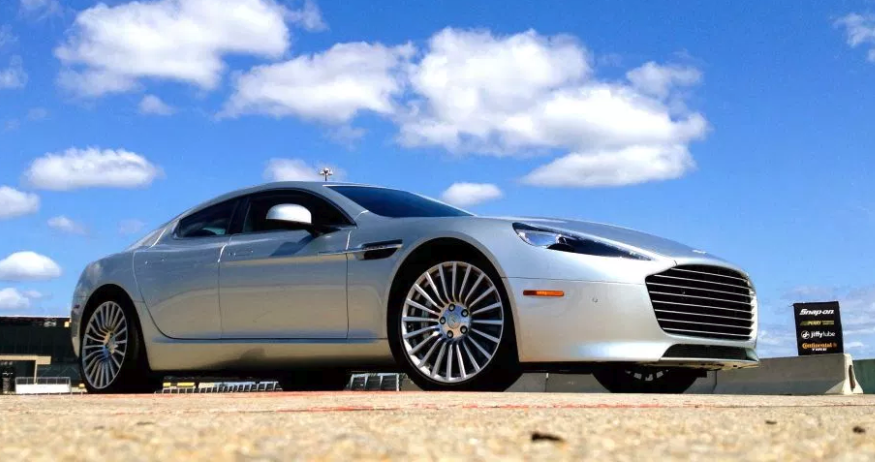First Drive: 2015 Aston Martin Rapide S

Story by John LeBlanc
MIRABEL, QUEBEC — By simultaneously employing the steering wheel column-mounted shift paddles and arresting carbon fibre brakes, the new Aston Martin I am piloting at Quebec’s iCar race track instantly drops two gears from fourth to second and suddenly sheds speed. With its front mid-mounted engine and rear transaxle, the British built car’s weight balance is nearly perfect, which allows for a precise pirouette around a double apex at the end of a long back straight, willing the car (and driver) to continue carving up this tight airport runway circuit.
You may assume I am piloting one of the famous marque’s two-seat Vantage or Vanquish sports cars. Instead, I’m enjoying typically terrific Aston Martin driving dynamics in a luxurious four-door sedan — a.k.a. the Aston Martin Rapide S.
It’s easy to understand if you have forgotten about Aston Martin’s 2+2 sedan. Better known for its two-seat and 2+2 coupes, the sexy Aston Martin Rapide can easily get lost in a luxury car buyer’s memory banks. But after a morning sampling the Rapide S (and its smaller Vantage and Vanquish brethren) the driving sacrifices are minor if you want to take three extra passengers along with you in ballsy Aston Martin style.
First seen as a concept in 2006, the rear-wheel-drive, four-passenger Rapide first went on sale four years later as Aston Martin’s first four-door since the Lagonda. Using the same extruded and bonded aluminum architecture as the Vantage, DB9 and Vanquish, the Rapide is about a foot longer than the DB9 to accommodate the two extra rear entry portals.
Like any Aston Martin, you could justify the purchase of a vehicle like my $233,192 Rapide S (fitted with $15,197 worth of options) to your financial advisor simply on the car’s beauty alone. Unlike Porsche, which made aesthetic compromises to make the Panamera as roomy as the BMW 7 Series and Mercedes-Benz S-Class, the Rapide won’t be confused as anything less than an Aston Martin from afar.
In 2013, the Rapide S was introduced as a mid-cycle refresh. Outside, its front end was redesigned, primarily focusing on a larger and more prominent front grille. More importantly, the original twelve-cylinder gas engine was reworked extensively to boost the four-door’s performance benchmarks.
Now sporting 552 horsepower and 465 lb.-ft. of torque, the hand-built, 5.9-litre V12 allows the Rapide S to hurl itself from a standstill to 100 km/h per hour in just 4.4 seconds, thanks to a rear-mounted eight-speed automatic, before topping out at 325 km/h. If you have to ask, Aston Martin says the Rapide S gets a combined city/highway fuel economy estimate of 12.9 L/100 kilometres, a figure I gleefully did not achieve banging around the iCar circuit.
Although the Aston Martin four-door may not be as quick as the 570-horsepower Porsche Panamera Turbo S, the naturally aspirated V12 is more of an aural delight in usage. It wails and howls are directly linked to what your right foot is doing, and while the Rapide S gets a fancy Bang & Olufsen sound system with pop-up dash tweeters, I did not feel the urge to turn it on during my time in the car.
Beyond straight-line heroics, though, where the big Aston Martin four-door shines is when it’s asked to change directions. For a car as long as a Chrysler 300, the Rapide is communicative and nearly as much of a delight to drive on a race track as any other Aston Martin.
Yes, when a non-race driver like yours truly leaves the braking too late, the Rapide S will understeer. But a bit of trail braking will bring its rear end in line. Hydraulically assisted, the steering system is quicker than the DB9 to counter the Rapide’s longer wheelbase. It’s also evenly weighted, smooth and accurate.
During cool down laps over the less-than smooth iCar track’s tarmac, the Rapide S is never too harsh. Like all Aston Martins, the ride is supple yet tightly-dampened. Smooth can also be used to describe the eight-speed automatic. Left on its own, it responds quickly to down- and up shifts. When using the paddle shifters, the V12 torque allows for quick cog swaps and when performing low-speed, paddock parking maneuvers, there’s none of the jerkiness found in some dual-clutch system gearboxes.
While Aston Martin has upped its sedan’s performance, the Rapide S’s cabin remains a luxurious place to reside when you’re not chasing Vantages and Vanquishes around a closed course. The workmanship is world class with much of the assembly done by hand. Once past the Rapide S’s rear doors that typically open in Aston Martin “butterfly” fashion, the automaker readily admits the rear seats are only suitable for children or adults out for an evening.
Relative to a Bentley Flying Spur, sitting in the one of the Aston Martin’s rear bucket seats is cozy. Regardless, I could get comfortable while seated back there with my racing helmet just brushing the headliner. In addition, there’s 301 litres of rear cargo space. Fold the twin rear seats and the carrying capacity grows to 750 litres, which makes for plenty of luggage for a weekend getaway accessed via a large rear hatch.
Aston Martin has already confirmed that it will jump onto the lucrative luxury-SUV bandwagon with the DBX crossover, an electric all-wheel-drive utility vehicle that debuted this year at the Geneva Motor Show. Until the DBX goes on sale, as the most practical Aston Martin you can buy, the 2015 Rapide S easily makes a case for itself for those who want to experience the famed British brand’s best qualities on a day-to-day basis. And for buyers looking for fun when no one else is onboard, it’s good to know the Rapide S can easily handle a day at the track.





![[del.icio.us]](https://www.straight-six.com/wp-content/plugins/bookmarkify/delicious.png)
![[Digg]](https://www.straight-six.com/wp-content/plugins/bookmarkify/digg.png)
![[Facebook]](https://www.straight-six.com/wp-content/plugins/bookmarkify/facebook.png)
![[Google]](https://www.straight-six.com/wp-content/plugins/bookmarkify/google.png)
![[Reddit]](https://www.straight-six.com/wp-content/plugins/bookmarkify/reddit.png)
![[StumbleUpon]](https://www.straight-six.com/wp-content/plugins/bookmarkify/stumbleupon.png)
![[Twitter]](https://www.straight-six.com/wp-content/plugins/bookmarkify/twitter.png)
![[Email]](https://www.straight-six.com/wp-content/plugins/bookmarkify/email.png)